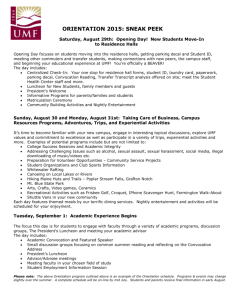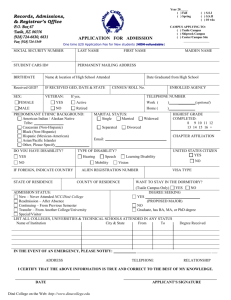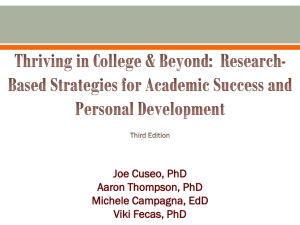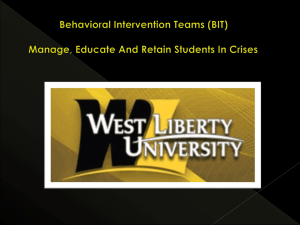THE EFFECTS OF STUDENT INVOLVEMENT IN CAMPUS LIFE ON
advertisement
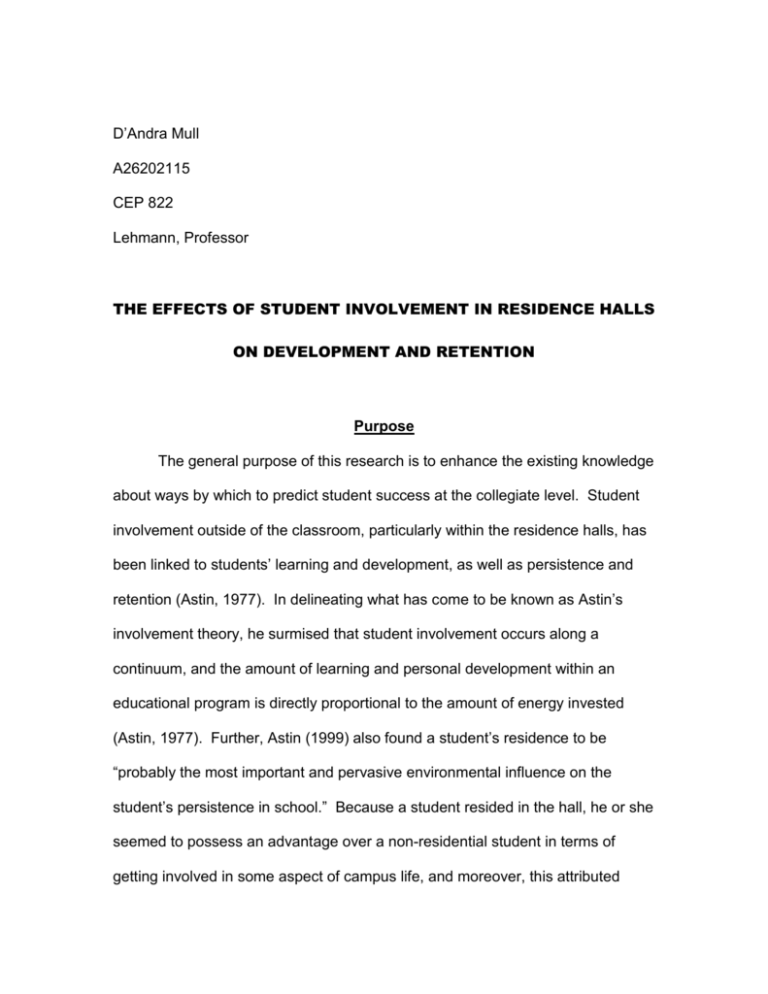
D’Andra Mull A26202115 CEP 822 Lehmann, Professor THE EFFECTS OF STUDENT INVOLVEMENT IN RESIDENCE HALLS ON DEVELOPMENT AND RETENTION Purpose The general purpose of this research is to enhance the existing knowledge about ways by which to predict student success at the collegiate level. Student involvement outside of the classroom, particularly within the residence halls, has been linked to students’ learning and development, as well as persistence and retention (Astin, 1977). In delineating what has come to be known as Astin’s involvement theory, he surmised that student involvement occurs along a continuum, and the amount of learning and personal development within an educational program is directly proportional to the amount of energy invested (Astin, 1977). Further, Astin (1999) also found a student’s residence to be “probably the most important and pervasive environmental influence on the student’s persistence in school.” Because a student resided in the hall, he or she seemed to possess an advantage over a non-residential student in terms of getting involved in some aspect of campus life, and moreover, this attributed immensely to a student’s social integration within the institution (Astin, 1999). As the student spent so much time within the university community, he or she had greater opportunities to interact with faculty, join student groups, become involved in hall government, or join a sorority or fraternity, all of which attributed greatly to the student’s chances of graduating and developing more on a personal level (Astin, 1999). With the data supplied by this study (and subsequent research), universities will be better able to understand some factors that can be attributed to student success, which in turn, aids them greatly in their retention initiatives. Definitions Development: To develop means to make active or promote the growth of, to cause to unfold gradually, or to expand by a process of growth. The journey to develop at the collegiate level could be thought of as being derived from the need to grow and succeed academically and intellectually, the need to expand knowledge and experience, and the need to gain immensely from one’s college experience. An individual who has developed through campus involvement, would possess the following characteristics: 1. Be more aware of issues of diversity within the university community. 2. Be more involved with campus activities and student organizations. 3. Be more likely to complete the baccalaureate degree. 4. Have more opportunities for interaction with the peer group and the university community. Prior Research Association of College and University Housing Officers-International and Educational Benchmarking, Inc. (2001). This project discussed the findings of ACUHO in terms of the level of activity of students at the collegiate level; further, the study also discussed the retention rates for the 2000-2001 school year and the patterns as they related to students who were involved in residence life clubs, groups, organizations, and activities. Astin, A. W. (1977). Four critical years. San Francisco: Jossey-Bass. Astin outlines a complete analysis of the impact of residence life and student involvement during the collegiate career, particularly as it relates to the overall development and success of the student. Astins’ writings included a number of samples of research from institutions of higher education on retention rates as they relate to a student’s connectiveness to the university. Further, Astin formulated the notion that a student’s residence was likely to be the most important and pervasive environmental influence on the student’s persistence in school, as though who live on campus often become more involved in campus life when compared to commuter students. Astin, A. W. (1999). Student involvement: A developmental theory for higher education. Journal of College Student Development, 40, 518-529. Astin, with a number of references to his previous research and writings, explains how student involvement directly impacts his/her motivation to remain in school, to apply for graduate or professional schools, and to excel academically. Astin also offers higher education institution insight into how much more developed students self-reported as it relates to their involvement in residence and campus life activities. Chickering, A.W., and Reisser, L. (1993). Education and Identity. San Francisco: Jossey-Bass. Chickering and Reisser explain how great of a role the university plays in helping students to develop personal competence, more mature interpersonal relationships, purpose, and integrity. Further, they also discuss how the university can assist in student development by establishing clear and consistent institutional objectives, by helping students to develop student-faculty relationships, and helping to establish educationally powerful environments. The authors also discuss how residence life department plays an intricate role in providing quality leadership opportunities by which students can learn a number of transferable skills. Chickering and Reisser discuss the importance of connecting academic units to residence life personnel, so as to provide students with a true support system as they strive to be retained and mature. Cress, C. M., Astin, H. S., Zimmerman-Oster, K., & Burkhardt, J. C. (2001). Development outcomes of college students’ involvement in leadership activities. Journal of College Student Development, 42, 15-27. The journal article explains the importance of connecting academics and community involvement in order to enhance a student’s interest in leadership experiences. Further, the article also discusses the notion that leadership skills are positively related to a student’s ability to impact other students and helps to develop these skills in others. The authors explain how leadership skills increases the chances of students working to promote interracial and ethnic understanding, as students work to broaden the circle of people they impact. Furr, S. R. and Elling, T. W. (2000). The influence of work on college student development. NASPA Journal, 37, 454-470. Furr and Elling discuss the factors that may attribute to residential students being unable to participate in hall and campus life, such as employment obligations, and help to explain the absence of some students from campus and hall activities. Furr and Elling surmise that students who work off-campus tend to be more removed from participating in activities outside of the classroom, whereas students who work on-campus seem to take an even larger interest in hall and campus life. Further, the students who work on campus also tend to have more contact with faculty and student organizations, which has a positive effect on their development and participation. Their writings also included research on majors for students; they found that student in majors such as business and engineering tended to know less about diversity and were less involved in campus activities, as opposed to majors such as education and social sciences. Inman, P., and Pascarella, E. (1998). The impact of college residence on the development of critical thinking skills in college freshmen. Journal of College Student Development, 39, 557-568. This article supports the notion that the inclusion of selected involvement activities had a slight, yet statistically significant increase in end-of-year critical thinking among freshmen, and through this finding, they surmised student involvement to be a key element in the process of student development. Kuh, G. D. (1995). The other curriculum: Out-of-class experiences associated with student learning and personal development. Journal of Higher Education, 66 (2), 123-155. Kuh’s writings surmised that residence hall students who took the opportunity to socialize with different racial, ethnic, and cultural groups enhanced their overall college experience, yet differences in communication and interaction styles (due to ethnic, cultural, or racial differences) also helped to contribute to difficulties among residents. These differences and difficulties were noted in their study of white and black students, where both cultural groups reported difficulties in understanding the other. Unfortunately, this caused some tension in a few situation, as rather than get to know each other, the residents simply pretended that the other group did not exist. Kuh goes on to talk about how this affected the level of involvement on the part of the students, which could hinder their overall development process. McCluskey-Titus, P., Oliver, R. S., Wilson, M. E., Hall, L. M., Cawthon, T. W., and Crandall, P. D. (2002). The relationship between community and academic achievement in residence halls. Journal of College and University Student Housing, 30 (2), 11-16. The journal article suggests that there is a moderate relationship between intellectual development and both social activity and sense of belonging, and assuming that sense of belonging is positively related to involvement, a great number more students should therefore, achieve academic success. Member of the floor community, which in turn, has a positive influence on resident’s academic endeavors, notes this through the dedication to academics. Pike, G. R. (1999). The effects of residential learning communities and traditional residential living arrangements on educational gains during the first year of college. Journal of College Student Development, 40, 269-284. This article discusses research that supports the theory that students who live in residence halls in which involvement in out-of-class activities is higher (as in living-learning centers) experience greater cognitive gains than students who live off-campus. Further, Pike explores the theory that residence hall involvement is related to students’ satisfaction with their living environment, as determined by his study of 183 higher education institutions. Astin, A. W. (1993). Bass. What matters in college? San Francisco: Jossey- Bierman, S. E. and Carpenter, D. S. (1994). An analysis of resident assistant work motivation. Journal of College Student Development, 35, 467-474. Moore, J., Lovell, C., McGann, T. and Wyrick, J. (1998). Why involvement matters: A review of research on student involvement in the collegiate setting. College Student Affairs Journal, 17 (2), 4-17. Tinto, V. (1993). Leaving college: Rethinking the causes and cures of student attrition (2nd ed.). Chcago, IL: The University of Chicago Press. Warner, M.J., and Noftsinger, J. B. (1994). Increasing student involvement through residence hall lifestyle assignments and developmental programming. Journal of the Freshmen Year Experience, 6 (1), 91-114. Each of these journals articles are quite similar in that they each support the research that campus involvement is a great factor in whether a student is retained, and further develops more on a number of different levels that leads to greater academic, social, and intellectual success. They also each explore the role of residence life staff in helping these students to succeed and prosper in their environments through support, hall programs, and referrals to different campus and community resources. Hypothesis The more involved a student is in residence and campus life, the greater his/her chances are at being retained. Population An ideal population would be a study of freshmen at all colleges and universities across the U.S. Because this study would be nearly impossible to conduct, a study of the universities in the Big 10 would be used. Sampling The study will be conducted during the spring semester in the residence hall system and with commuter students. As this would require a great deal of time, this sampling would be modified by taking a random sample of students from these schools, and would be further modified to include only a random sample of second-semester freshmen across the study. Instrumentation Instrumentation will include a rating scale to be used to rate the degree to which each student was involved in hall and campus activities. Each student will place his student identification number on his/her survey, which we will use the following year to determine if he/she is still enrolled. A sample rating scale is shown below. Reliability: We can only go by the information reported by the students and the retention reports received by the university during the following fall. Validity: The self-reports of the students and their involvement with campus activities will be compared to their return (or not) to the university in the following academic year. . RATING SCALE 1-Strongly agree 2-Agee 3-Undecided 4-Disagree 5-Strongly disagree 1. I actively participate in hall activities 1 2 3 4 5 I do not participate in hall activities 2. I participate in campus activities 12345 I do not participate in campus activities 3. I know a lot about campus life 12345 I do not know a lot about campus life 4. I have learned a lot about other other cultures through the university 12345 I have not learned a lot about other cultures through the university 5. I plan to return to the university in the 1 2 3 4 5 fall I do not plan to return to university in the fall 6. I lived on campus this year 12345 I commuted this year 7. I have been to my professors’ office hours 12345 I have not been to my professors’ office hours 8. I am employed on-campus 12345 I am not employed oncampus 9. I am employed off-campus 12345 I am not employed offcampus Student Identification Number or PID _____________________________ Procedures Since the freshmen population at Big 10 institutions average more than 5,000, the surveys would be handed out at various residence halls that house freshmen over the course of three months. The surveys would be handed out to hall staff, to be distributed to each resident at community meetings; we will also request the help of resident assistants in administering the survey, as this could greatly aid in data collection. Extraneous variables (threats to validity) might include the reluctance of students to complete a survey, or only getting really active students to complete them. Further, students could falsify their involvement in campus and hall activities, which could greatly alter the results of the study, or they could falsify their student identification numbers, which would make their survey void. Data Analysis The data would be analyzed the following year to determine if student involvement has any impact on retention rates. This would be done by utilizing campus enrollment records to see how many students have returned for the sophomore year, and to take note of their previous year’s relationship with hall and campus life.
